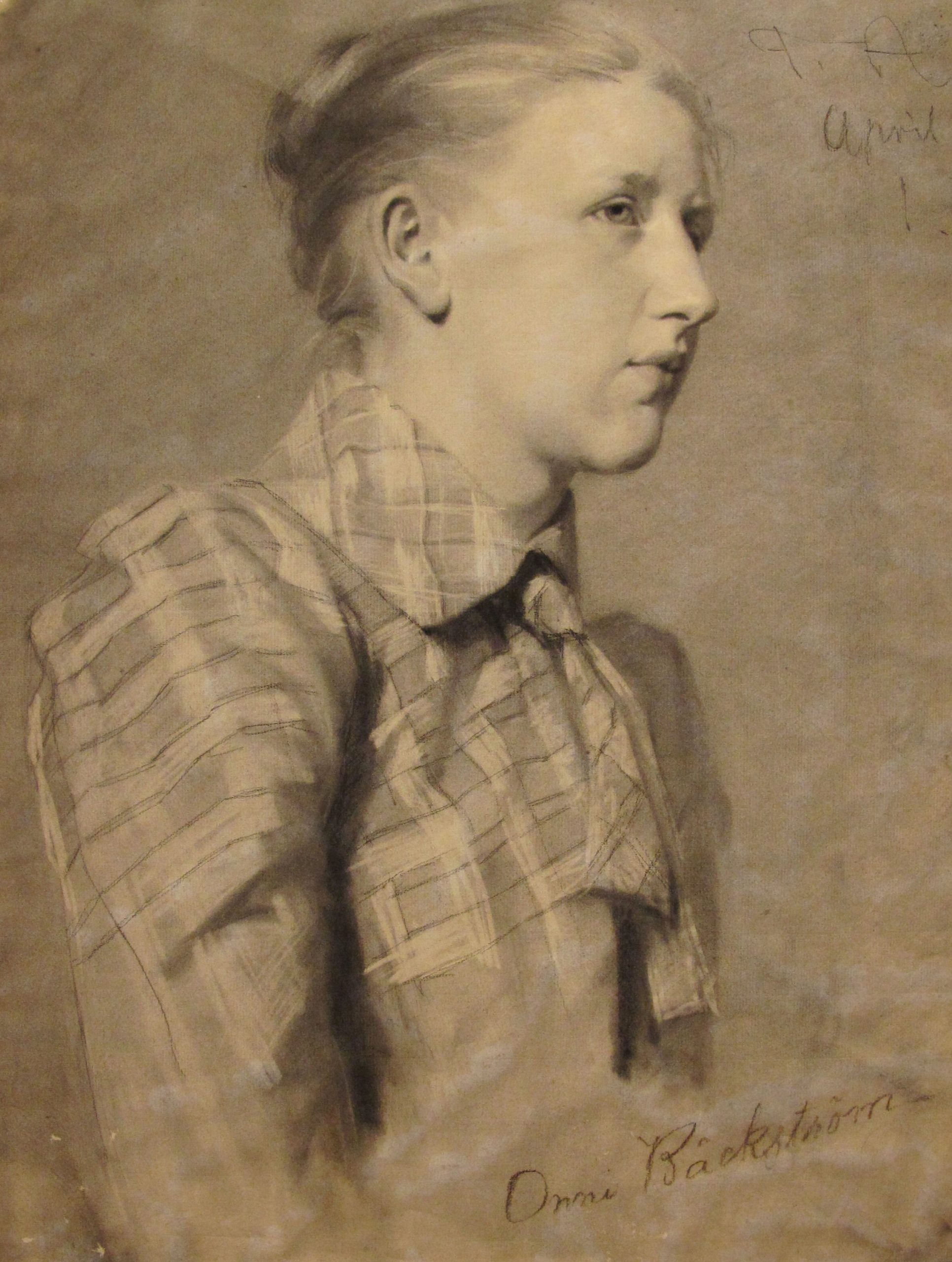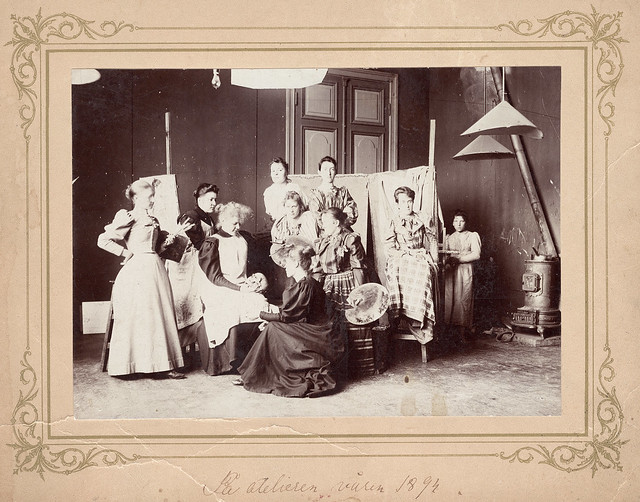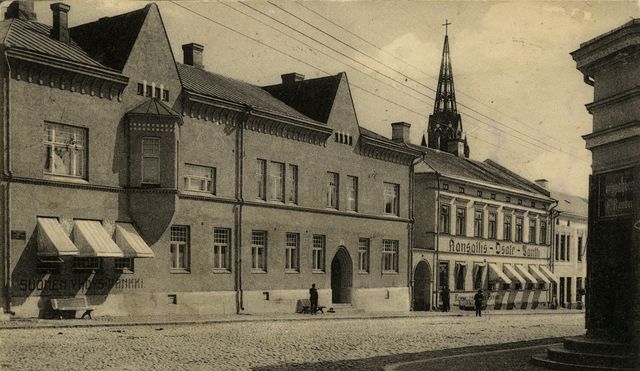The University of Helsinki Art Room holds an impressive collection of drawings, but the identity of some of the artists is not known. The signatures, if any, may be unclear, and notes made on the drawings may sometimes be misleading.
As I was cataloguing the drawings in our database and conducting online searches to establish the identity of the artists, I came across a skilled drawing entitled Portrait of a Young Woman, which showed the profile of a woman, from a slightly downward angle, with her hair in a bun and wearing a check shirt. At the bottom of the paper was the name Onni Bäckström, while at the top were the initials F. A. followed by ‘April 93’. Based on what I saw, I immediately assumed that the artist was a male student called Onni Bäckström. The initials at the top were of the person who had approved the work: Fredrik Ahlstedt, a teacher at the Art Room.

Who was Onni Bäckström?
I did an internet search. It turned out that Onni Bäckström was not a man, but a woman, who had studied at the Finnish Art Association’s drawing school in the Ateneum building, which now houses the Finnish National Gallery. Onni’s identity was confirmed by a group photo from 1894 included in the photographic collections of the National Gallery and showing a group of female students at the Ateneum.
Did this mean that I had discovered an unknown female artist? Onni had, in fact, been Fredrik Ahlstedt’s student and, though clearly accomplished, had slipped into obscurity. I continued my internet searches and found out more about Onni’s background. She was born in 1872 in Noormarkku in western Finland and christened as Onni Amanda. Her mother, Ida Amanda née Gestrin, was a sister to the artist Elin Danielson’s mother, Rosa Danielson, née Gestrin. Onni’s sister Irene was married to Knut Tallqvist, professor of Semitic languages at the University, and her brother Harald was a lawyer working at the Turku Court of Appeal. Her father Selim Bäckström managed the ironworks in Noormarkku.
Brages Pressarkiv has a large biographical archives in Helsinki, so I headed there in the hope of finding Onni’s obituary or at least her death notice. I found both. I discovered that Onni Bäckström died from complications caused by an accident in 1935. She had worked for the Union Bank of Finland, later the Nordic Union Bank, in Pori for three decades and, once retired, moved to Helsinki eight years before her death. Onni is described in her obituary as a lively and cheerful person. I felt a sense of disappointment. Perhaps I had not found a forgotten female artist after all.
Why did Onni not become an artist?
I contacted the National Gallery’s researcher services to enquire whether the Finnish Art Association’s register included information on Onni or whether the archive of newspaper clippings contained any mentions of her exhibitions. Her name was found in the register: she had been an art student from 1891 to 1893. But there was no mention of her in the newspaper clippings. Onni’s artist cousin Elin Danielson, 11 years her senior, worked as a teacher at the Association’s drawing school between 1890 and 1894, precisely when Onni studied there. Did Elin encourage her cousin to pursue her art studies? At the turn of 1894–1895, Elin moved to Italy. Perhaps her move had an effect on Onni’s studies? Onni had applied for a travel grant from both the Hoving Fund and the National Board of Industry in 1894. Apparently both her applications were rejected. I wondered why Onni never finished her art studies. In May 1893 she and a few other students received financial aid from the Finnish Art Association. She was granted 100 Finnish markka (approx. 450 euros), the highest sum awarded.

Onni graduated from the model drawing class of the Helsinki drawing school in May 1892 and was granted the right to begin her studies in the painting class. She had received encouraging awards from the Art Association, including the Die Kunst für Alle book and, in another year, a silver drawing instrument. Her teacher at the drawing school was the artist Fredrik Ahlstedt. According to the National Biography of Finland, Ahlstedt worked as the teacher of the model drawing class of the Finnish Art Association’s drawing school until 1893. Ahlstedt was also the acting drawing teacher at the University’s Art Room during the 1893 spring term and was granted a permanent appointment at the beginning of the following autumn term.
Next, I studied the works of art associated with Ahlstedt in the National Library of Finland’s Finna database. Ahlstedt also taught the Finnish artist Pekka Halonen. He had marked his initials and the month and year at the top of Halonen’s drawings as a student, just as in Onni’s drawing. The caption for the photo mentions that Ahlstedt approved his students’ works by adding his initials at the top. In other words, he had approved Onni’s skilled portrait of a young woman in April 1893.
So, Onni Bäckström studied under Ahlstedt’s tutelage, but possibly also at the University’s Art Room, which was common at the time. But why is the Portrait of a Young Woman included in the collection of the Art Room, rather than that of the Ateneum? Could Ahlstedt have bought the skilled drawing from his student and used it in his teaching at the Art Room, where he worked already in spring 1893? Onni could, of course, have kept the drawing as a memento of her student life.
Onni in Pori
I carried out a number of searches in the National Library of Finland’s excellent digital newspaper archive. The mystery surrounding Onni began to unfold. I discovered that the Pori-based Björneborgs Tidning newspaper had reported that Onni Bäckström, who was living in Pori, had graduated in May 1896 from Björneborgs Handelsinstitut, probably referring to a commercial school established in 1892. Onni had apparently returned to her home region in the mid-1890s to study for a profession that would provide a more secure income. Based on information I found in newspapers, Onni worked for 30 years as a bank teller at the Nordic Union Bank, leaving her post on 31 January 1927. She also worked as an accountant for the local animal welfare society and women’s gymnastics team and was an active board member of a company operating an ice rink in Pori.

The Bäckström family had suffered a tragedy when Onni was studying in Helsinki. Her father Selim had been ill for a long time and was unable to manage his finances. After his recovery, Selim Bäckström refused to provide for his family. In June 1893 the family applied for him to be declared legally incompetent and eventually brought an action against him in the local district court. Having received the summons, Selim hanged himself in the attic of his home in Finpyy, Noormarkku, in June 1893.
We can only surmise what led Onni to quit her art studies and return to her home region. It is likely that she simply could not afford to continue her studies in Helsinki after the family’s impoverishment and could not move forward on her artistic path due to the rejection of her applications for a travel grant.
Pia Vuorikoski, Head of Exhibitions
Translation: University of Helsinki Language Services.
